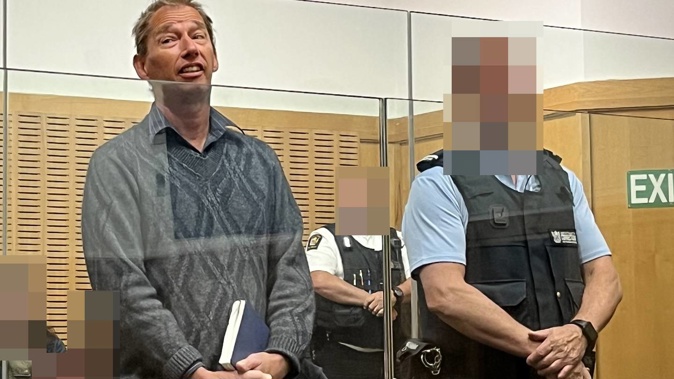
Convicted saboteur Graham Philip went public with his plan to bring down the national power grid on an independent radio show.
Philip, a 62-year-old IT professional and Covid conspiracy theorist was yesterday handed a three-year jail sentence for the crime of sabotage.
But prior to his act, which lead to the charge and eventual conviction, he went public with his plans.
In an audio clip from his Telegram radio show, Philip said he thought he and his listeners had full rights as citizens to say “no, we are going to make a citizen arrest”.
“And I think in order to do that it would be perfectly legitimate to dismantle part of the power grid to dismantle the national microwave circuits and to break the national fibre optic ring to get out of this brainwashing that we have got,” he said.
“You know, it’s something I have been exploring as a civil rights protest not as an act of terrorism as a civil rights protest because of this mind control that you’re talking about.”
/cloudfront-ap-southeast-2.images.arcpublishing.com/nzme/LWVI6HNWLRB3HEQK67FBM63PTI.jpg)
Graham Philip appears in the Rotorua High Court on Thursday. Photo / Ethan Griffiths
Philip was charged with seven counts of wilful damage last December. The charges were upgraded to seven of sabotage earlier this year. He was also convicted of unlawfully entering agricultural land.
The charges relate to attacks on Transpower infrastructure last November, which caused approximately $1.25 million in damage. One of the attacks caused a fire.
If successful, “the consequences of the damage could have been very grave”, Crown Prosecutor Amanda Gordon previously told the High Court. Further details of the offending, including precisely what Philip attacked and his method of doing so remain suppressed.
It was previously reported by Open Justice that he was motivated by one purpose - causing as much disruption as he could in an effort to draw attention to his cause.
That cause was a catalogue of fanatical conspiracies surrounding the Covid-19 pandemic and the rollout of vaccines.
His conviction in his beliefs saw him turn into an almost full-time campaigner. He had hundreds of followers online, with his postings garnering significant traction within Aotearoa’s conspiracy and “doomsday prepper” circles.
The 62-year-old’s lead supporters created hype around him and convinced others he was innocent.
/cloudfront-ap-southeast-2.images.arcpublishing.com/nzme/IPK5HHDQWQSH2N2I6WFTUV3ZCI.jpg)
Graham Philip, pictured here on New Year's Day 2003, takes a ride in a ski biscuit at Lake Okareka. Photo / Kelvin Teixeira
Philip was born in the UK, growing up in a rough area of London. As a young child, his family moved to Petone, where his father had secured work.
According to one of Philip’s many books, his childhood was marred with abuse and fear. His father, a steel fabricator he described as a “schizophrenic communist”, emotionally manipulated Philip and his brother David, he wrote, referring to them both exclusively as his “little swines”.
He later returned to the UK as a young man in his 20s, working as a sound engineer at Dolby’s London office. It was while working there Philip received a letter with unsettling news.
In 1988, his brother David was tried after being alleged to have killed Kyung Eup Lee, a South Korean fisherman, at Melbourne Railway Station. He was sprung after a letter he wrote saying he had “done in a Korean” was intercepted by New Zealand authorities.
Philip, still in London, flew to Melbourne weeks later to visit his brother.
He arrived to discover it had been alleged David also cooked the man’s body parts in a wok and displayed Lee’s severed penis in the station’s female bathrooms.
/cloudfront-ap-southeast-2.images.arcpublishing.com/nzme/6OC7FXZ2JRDLVAT2LQJDUWMKHQ.jpg)
07/03/1989. David William Philip, the cannibal killer as he appeared at Hawthorn Court in 1989 over the 1988 murder and cannibalism of 42-year-old vagrant Kyung Eup Lee. Photo / NEWS LTD
David was later found not guilty by reason of insanity and remains in a mental health institution today. Philip was convinced the murder occurred as a result of childhood trauma.
“I became a Christian when I was 19 and Jesus Christ has healed me of all that. Otherwise, I’d be just like David,” he wrote.
But those younger years defined by discontent didn’t plot Philip on a course of crime or despair, at least until now. Most of his life could be described as somewhat normal.
Philip’s time since moving back to New Zealand is difficult to piece together. He lived in Hāwera, South Taranaki, before moving to the Taupō region.
Open Justice has seen educational records showing Philip is qualified in the IT sector, in which he was employed for a time at a computer repair shop in Taupō. At one point, it appears Philip went out on his own and contracted his services to various businesses.
He is a devout Christian, with the court hearing he subscribes to many fundamentalist views.
A 2003 photograph taken by the Rotorua Daily Post shows Philip grinning ear-to-ear while riding a biscuit on Lake Ōkāreka on New Year’s Day.
He is married to Marta, a softly-spoken Brazilian woman with a thick accent. The couple has three children together.
After reviewing hundreds of messages and listening to hours of podcasts posted by Philip, Open Justice reported the content of these painted a picture of a deeply worried man, convinced the lives of New Zealanders were at risk from “Government tyranny” and an “experimental vaccine” he viewed as a tool of genocide.
On September 29, an officer visited Philip’s home after an altercation at a bank where Philip was denied entry for refusing to wear a mask. He had donned a snorkel instead.
Philip took a photo of the officer’s badge number and posted it online. “When the trials start, we must remember his number and make him pay for the crimes against NZ people.”
Philip later changed his bio on one messaging platform to “satire, comedy, and fiction”. He posted a legal disclaimer, saying all of his postings were for “the purposes of personal entertainment”.
Part of his online postings included not-so-subtle suggestions that members of the public should attack critical infrastructure. He posted pictures of substations and suburban transformers.
“In our team of five million, there are about two million extremely pissed-off people today. Most of those annoyed people have spanners and welders and metal cutters and a variety of machine tools,” he posted last year.
In late November, he began to undertake his own attacks. While the details of those attacks remain subject to strict suppression orders, today those orders were relaxed slightly, allowing media to report it was Transpower infrastructure that had been targeted.
The only other facts that can now also be reported are that the offending caused $1.25 million in damage and one of the acts led to a fire.
Graham Philip’s case whipped up hysteria among online conspiracy circles, fuelled by accusations that he was a “political prisoner”, held without charge or trial.
After his December 8, 2021, arrest was revealed among these circles, a campaign began to get Philip released.
At this point, details on what he had done were not widely known, although some did breach both the order covering the offending and Philip’s name suppression order.
/cloudfront-ap-southeast-2.images.arcpublishing.com/nzme/JQGR7AYNK2BN7NFKBRW6KGWA7I.jpg)
Supporters of Graham Philip outside the Rotorua High Court, with wife Marta third on the left. Photo / Facebook
A Facebook page, Free Graham Philip, appeared online. Videos on the page predominantly fronted by his wife Marta talk of Philip as a “family man”.
Most online conjecture alleged a similar theme; the Government wished to arrest Philip, ordered the police to do so, kept him as a “political prisoner”, and were so worried about people finding out they instituted a blanket suppression order on the details of the offending.
Soon, hundreds of people were reacting to posts on the page, most of which were either videos from Marta or photographs of letters Philip had sent from prison.
Pleas for donations to his legal fees began to be posted, with many donating to the cause. Some even held garage sales in Taupō to raise money for him.
When Philip pleaded guilty, the page began posting further videos and letters from him in which he professed he was innocent.
A letter written by Philip, posted to the page just last night, says that he felt he was “coerced into pleading guilty”.
That is at odds with his actions at the High Court in Hamilton, confirming to the judge his pleas of guilt.
Outside court, Marta was in tears as she spoke to a variety of fringe “journalists”.
“We will not be destroyed. We are not defeated. I claim victory in the name of Jesus.”
Take your Radio, Podcasts and Music with you









